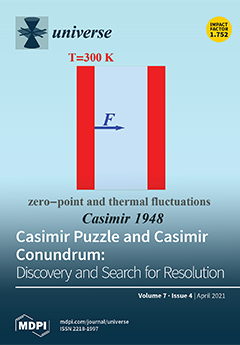The standard Lense–Thirring metric is a century-old slow-rotation large-distance
approximation to the gravitational field outside a rotating massive body, depending only on the total mass and angular momentum of the source. Although it is not an
exact solution to the vacuum Einstein equations,
[...] Read more.
The standard Lense–Thirring metric is a century-old slow-rotation large-distance
approximation to the gravitational field outside a rotating massive body, depending only on the total mass and angular momentum of the source. Although it is not an
exact solution to the vacuum Einstein equations, asymptotically the Lense–Thirring metric approaches the Kerr metric at large distances. Herein we shall discuss a specific
variant of the standard Lense–Thirring metric, carefully chosen for simplicity, clarity, and various forms of improved mathematical and physical behaviour, (to be more carefully defined in the body of the article). We shall see that this Lense–Thirring variant can be viewed as arising from the linearization of a suitably chosen tetrad representing the Kerr spacetime. In particular, we shall construct an explicit unit-lapse Painlevé–Gullstrand variant of the Lense–Thirring spacetime, one that has flat spatial slices, a very simple and physically intuitive tetrad, and extremely simple curvature tensors. We shall verify that this variant of the Lense–Thirring spacetime is Petrov type I, (so it is
not algebraically special), but nevertheless possesses some very straightforward timelike geodesics, (the “rain” geodesics). We shall also discuss on-axis and equatorial geodesics, ISCOs (innermost stable circular orbits) and circular photon orbits. Finally, we wrap up by discussing some astrophysically relevant estimates, and analyze what happens if we extrapolate down to small values of
r; verifying that for sufficiently slow rotation we explicitly recover slowly rotating Schwarzschild geometry. This Lense–Thirring variant can be viewed, in its own right, as a “black hole mimic”, of direct interest to the observational astronomy community.
Full article





